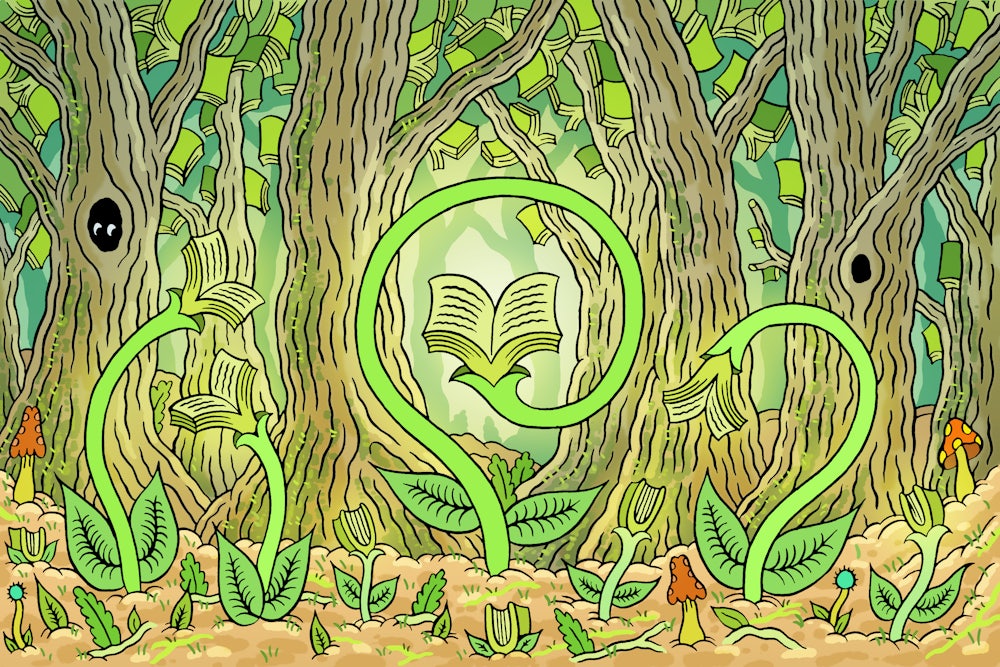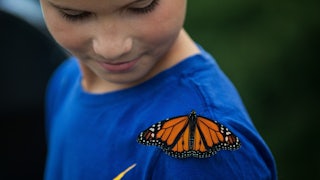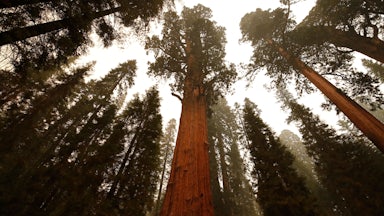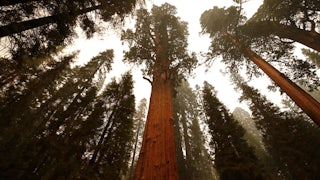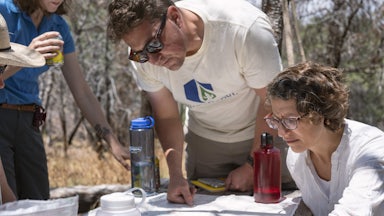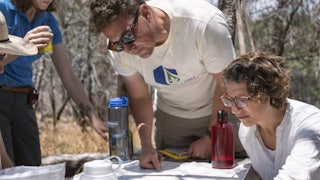On a sweater-weather Saturday in June, a crowd of several hundred gathered at a trailhead near the Line 1 rapid transit out of Oslo. The scruffy grad students, smiling parents, and snowsuit-wearing toddlers had made the 45-minute trek from the Norwegian capital to participate in a burgeoning tradition called Future Library. Each year, a growing number of spectators take a day out of their normal routines to witness a world-renowned author hand over a manuscript that no one in attendance—indeed, perhaps no one alive on earth—will ever read.
This year was special: Three new books were to be presented, after the 2020 and 2021 ceremonies were postponed due to the pandemic. But American poet Ocean Vuong contracted Covid-19 ahead of the ceremony; in lieu of attending, the author of Time Is a Mother sent his regards—and a trio of throat-singing Buddhist monks to bless the forest. That left just two authors to transfer their secret stories to the city of Oslo for a century of safekeeping: Karl Ove Knausgård, a native Norwegian best known for his six-part autobiographical novel, My Struggle, and documentarian and writer Tsitsi Dangarembga, whose 1988 debut novel, Nervous Conditions, was the first English-language novel to be published by a Black Zimbabwean woman.
When Dangarembga, Knausgård, and the rest of the Future Library clique arrived, the spectators followed them eagerly into the forest. Arrows drawn in sawdust on the forest floor led the way to a stand of around 900 trees, planted here in 2014 so that they might be harvested by future generations for the first print run of Future Library—100 volumes, collected over the next 100 years, and published all at once in 2114. In the scraggly grove, volunteers sported T-shirts that read like tombstones (“Future Library / 2014–2114”) and doled out chocolate wafers and campfire-warmed coffee. Locals sat knee-to-chin on their portable mats—collapsible foam, calfskin, nylon. The rest stood upon the forest floor, thick with mulch, moss, and ants from a nearby colony.
As climate change accelerates, and the world is racked by ever more intense fires, droughts, hurricanes, and heat waves, there is a widespread sense that time is running out. And Future Library is nothing if not a meditation on time—a theme explicitly addressed in the songs and speeches accompanying this year’s presentations. While a century is of little consequence to most tree species, to a human being—or at least, to the subset of human beings assembled in the forest that Saturday—it is difficult to imagine. “Will there be a ‘Norway’? Will there be a ‘forest’? Will there be a ‘library’?” the novelist Margaret Atwood, who contributed Future Library’s first volume in 2015, pondered in an essay on the project. “It’s hopeful to believe that all of these elements—despite climate change, rising sea levels, forest insect infestations, global pandemics, and all of the other threats, real or not, that trouble our minds today—will still exist.”
Yet in its heartwood, Future Library is just another time capsule—a popular response since the nineteenth century to the feeling of impending doom. For all their apparent focus on the future, most time capsules, Future Library included, are profoundly rooted in the present, with its many biases and limitations. Whether an iron safe or a silent room, they hold tight the material objects that the living value now, the anxieties we share today, and the determination to be remembered by someone, somewhere.
But standing in the Nordmarka, as the echoes of the chanting ebb, the message in the bottle feels largely beside the point. What matters, at least for now, are the hands fastening the cork.
The notion of writing unread books began with Katie Paterson, a Scottish conceptual artist known for her work on geological time. Almost a decade ago, the developers tasked with reviving Oslo’s downtown port, the Bjørvika, were looking for artists to make the most of their budget earmarked for art in public spaces. Paterson, inspired by the rings of a tree, wondered if it would be possible to commission one book a year for a century—and not let anyone read them until the entire collection was completed. The developers evidently liked it, and Paterson set about planting trees and enticing writers.
The notion of the time-dated vessel, which preserves objects and dictates a designated date for reopening, emerged in Gilded Age America, as historian Nick Yablon writes in Remembrance of Things Present. The first two such time capsules—the Century Safe and the Memorial Safe—were developed independently for the nation’s centennial celebrations in 1876. Each was filled mostly with photographs and assigned a 100-year expiration date.
Those first time capsules reflected a growing anxiety about the rate of technological and social change underway in the United States. Americans worried about how (or whether) they would be remembered, Yablon writes. So they began to craft what he calls “prospective memories of their present.” And everyone wanted in: Anti-union actors and labor organizers, eugenicists and African Americans, robber barons and socialists all craved their own capsule. “For each group,” Yablon writes, “a sealed vessel was a totem of a future age in which their vision—conservative, reformist, or radical—would be realized.”
These projects for posterity continued to grow in popularity and ambition, but their hauntological qualities remained much the same. Amid the global upheaval of the 1930s, time capsule designers planned for unimaginably distant futures, as evidenced by Westinghouse’s 1939 World’s Fair capsule (intended for the year 6939 C.E.) and Oglethorpe University’s Crypt of Civilization (to be opened in 8113 C.E.). In 1977, NASA sent the Golden Records to space, with the hope the sounds and images of Earth would reach extraterrestrial life at some point in the next 40,000 years. And while time capsules now rarely make headlines, public interest shows no sign of slowing: The International Time Capsule Society has registered more time capsules since 2020 than in any period since the organization was founded in 1937, due in part to the unprecedented upheaval of the pandemic.
Like much of Paterson’s art—curtains over a gallery window dyed the color of the first star in the universe, or the eerie tinkling of Beethoven’s Moonlight Sonata after radio waves carried each note to the moon and back—Future Library feels like an attempt to converse with the Anthropocene itself. As humans dither in an era of mass extinction and global warming, the question of who will live to remember us is omnipresent. It’s also reflexively coupled with a related but antagonistic query: “Why do we, the ones who failed to stop this, deserve to be remembered at all?”
As if responding to this largely unspoken dialectic, Future Library subverts some of the existing tropes of the time capsule: “We,” the participants, are not communicating to the future—“they,” the 100 authors, are. Anyone can choose to witness the handover ceremony, but the vast majority of humankind will contribute nothing to the library itself. In this way, the project gently rhymes with a foundational fact of the climate crisis itself: It is a tyranny of the carbon-saturated few over the many who will feel its effects.
And while other capsules are static—plunged into the earth in a single instant—Future Library is always changing. The first authors will be dead by the time the spines of their books are cracked, but as the clock winds down, Future Library contributors of the 2100s will be writing for their contemporaries. This could be misconstrued as a bug (maybe nobody really thought this thing through?), but to Paterson it’s a feature: “The tree ring is such an emblem of time like that,” she tells me, as her school-age son spins around her like an energetic planet. “It contains—and you can see visibly—the change in the years, yet it’s visibly moving, and never in a straight line.”
If Paterson is the artist behind Future Library, Anne Beate Hovind is the engineer. As the commissioner of public art for the Bjørvika district developers, Hovind has supported the project from its inception, going so far as to lend Paterson a family cabin so she could work out her ideas in the woods. “Everyone says [Future Library] had to happen in Norway or Oslo,” says Hovind, whose family has lived in the region for at least 14 generations, since the Viking age. She was skeptical of this sort of comment—which seems to imply that Norwegians’ love of the outdoors translates into automatic comprehension of global catastrophe. “It seems like it’s taken more time for Norwegians to connect to the project,” Hovind adds.
Norway’s place in the story of climate change is complicated. Oslo was in the middle of a drought in June, and drought conditions are contributing to forest fires that may one day threaten the Future Library trees. But Norwegians have mostly been “living a very comfortable life up here in the north,” Hovind says. “It’s peaceful, it’s rich, we have lots of nature. We are not threatened in any way.”
If anything, Norway is among the threats. In 1969, two days before Christmas, the Phillips Petroleum Company discovered the first oil in the North Sea, at the southwestern edge of Norway’s waters. In the 50 years since, the Ekofisk site alone has produced three billion barrels of oil. The Norwegian government had no expertise in oil and gas at the time, but politicians were determined to keep the growing wealth within their borders. With the “10 Oil Commandments,” Norway nationalized the natural resource in 1971—and effectively created its own Saudi Aramco. Today, the country produces about two million barrels of oil a day, making it the thirteenth-most-productive oil country in the world.
Petroleum remains the slick, black bedrock of Norway’s $1.3 trillion sovereign wealth fund, the world’s largest. The so-called Oil Fund, which is administered by the state on behalf of just 5.3 million Norwegians, controls 1.5 percent of all shares in publicly traded companies in the world and subsidizes its socialist government. (It also indirectly helped to pay for my trip: Norway sponsored journalists’ travel to cover Future Library, the opening of the new Nordic National Museum, and other arts events.) While the fund is making changes that occasionally align with climate goals—it sold its last fossil fuel investments in 2021, after years of losses—the state is still granting offshore drilling licenses, and politicians have yet to articulate what a postcarbon Norway would really look like.
Future Library may challenge other facets of life in Norway too. For example, Norwegians are known for their strong sense of allemannsretten, or the right of all men to access nature. It’s a belief exemplified in art and in law, from the works of the early twentieth-century sculptor Gustav Vigeland to the “right to roam” codes that grant everyone the right to move through any uncultivated land, including land that is privately owned. But such unbridled access to nature may end up posing challenges for Future Library. Already, the grove appears to be at capacity for the annual handover ceremony—and organizers aren’t in a position to throttle access to a public forest. For now, the best alternative is to livestream the event from home instead.
Yet Future Library is structured around this sense of scarcity and the desire it breeds. For some, creating a library for unborn generations is a source of frustration. As one spectator put it, the project feels less like giving something to the future than withholding something from people alive today. But for others, this is the part of Future Library that has the most appeal. “Not everything is for us to be consumed now,” Dangarembga, the Zimbabwean novelist, told a crowd at the public library downtown. Growing up between Southeastern Africa and England, “exclusion is so normal to me,” she explained. For citizens of the global north, who hoard wealth and power—at the expense of the planet itself—Future Library may offer a lesson long overdue.
On the eve of the 2022 handover ceremony, Paterson and two former Future Library contributors gathered at the edge of a windy crag along the Oslofjord to discuss time—specifically, the way the pandemic had altered their perceptions of it. For Paterson, time opened up in lockdown, enabling her to redouble her artistic efforts, she told the crowd, as the wind shook the blossoms from a nearby chestnut tree. For the Icelandic poet Sjón, who writes his books, including his 2017 Future Library submission, in an old fisherman’s house, time all but disappeared. And the British novelist David Mitchell, most notably the author of Cloud Atlas, who submitted his Future Library work in 2016, discovered he lived in a “time sandwich,” suspended between what has happened and what will happen.
This kind of conversation is, indeed, the stuff of undergraduate philosophy courses (and undergraduate philosophy majors’ high talk). But it is increasingly clear that our individual and collective experience of time is central to the way we live our lives, to the structure of our political systems, and, some argue, to human consciousness itself. While our predictions of the future—of how time will move forward from this point—will never be entirely accurate, we must continue to imagine something better if we are ever to achieve it. What’s more, this work of reimagining will not succeed if it is concentrated in the hands of only a privileged few.
Future Library, like all time capsules, is just one such vision of the future. But it offers every spectator a ready-made timetable for introspection: What does a century mean to you? What do you want that world to look like then? And what will you do to achieve it? Now it also offers a space: This June, the Silent Room, a nook in the new downtown public library, opened to the public. In a space made of tiny blocks of wood cut from the forest stacked together into a snug cathedral, the Future Library manuscripts will wait out the years until 2114. The rules are simple: Look, but don’t read—these are for the next generation.
